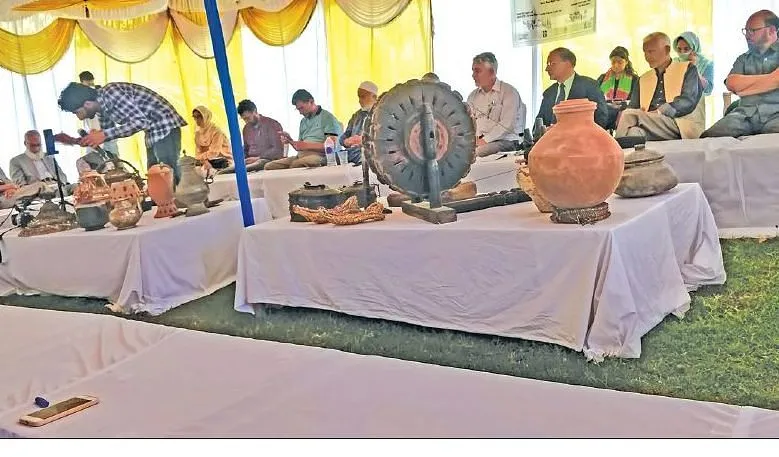Sopore: In an endeavor to preserve essence of Sopore’s popular heritage structure, Meeras Mahal, a community interaction was organised by the Indian National Trust For Art and Cultural Heritage (INTACH) Kashmir chapter and Help Foundation Jammu and Kashmir at Meeras Mahal Museum Sopore on Wednesday.
The event was attended by people from different shades of life, noted civil society members of Baramulla district besides members of Help Foundation and Adabi Markaz Kamraz.
The Meeras Mahal Museum of Ethnography was curated and managed by a phenomenal activist, educationist and public servant, late Atiqa Bano. The Museum is home to more than 7000 artifacts that provide an ethnographic lens into the rich cultural heritage of the Kashmir valley.
Most of the artifacts are items of daily use that were a common sight in Kashmir until the end of the twentieth century.
The collections mostly collected by Atiqa Bano during her life include terracotta, wood work, wicker and grassware, metal, (including jewellery), stone and manuscripts.
During the interaction the participants stressed upon the need to preserve the Heritage Mahal initiated by the Atiqa Bano. “The initiative started by the Atiqa Bano need to be preserved in its best,” said Muhammad Amin Bhat, president, Adabi Markaz Kamraz. “The future generation should be connected to our past for which Meeras Mahal Museum is a treasure,” he added.
M Saleem Beg, former DG of tourism and chairman of Indian National Trust for Arts and Culture Heritage (INTACH) J&K chapter while stressing upon participants to play their role in protecting our rich heritage, said that “it is our collective responsibility to safeguard our heritage,”
“The Meeras Mahal Museum is a rich cultural heritage. It is our collective responsibility to preserve it and carry forward it to our future generations so that our identity is protected,” Beg said.
The former Dean North Campus, Kashmir University, Professor Irshad Ahmad while hailing the efforts of Atiqa Bano said that the biggest tribute to the founder of the Meeras Mahal Museum will be to transmit her legacy to the future generation.
While suggesting the organisers to remain connected with different educational institutions, Irshad Ahmad said like in the rest of the country, the students or visitors are encouraged to visit museums, here in Kashmir too we need to inherit the same practice so that our cultural heritage is preserved and immortalised.
“The students as well as visitors should be encouraged to visit such museums so that they are connected with our past. The vibrant communities all across the world tend to foster their cultural heritage by ensuring their future generation is well versed with their past heritage,” he added.
Chairperson Help Foundation, Nighat Shafi, while stressing upon the need to safeguard Kashmiri language not merely by introducing it in educational institutions but by “encouraging it to be spoken at home so that foreign trends which have entered our homes are discouraged.”
“Apart from making our future generation well versed with our past, we need to practice and encourage future generations to speak it with clear intent instead of speaking words just out of habit or convenience,” Shafi said during her speech.
The Meeras Mahal Museum is the only museum apart from the government run Sri Pratap Singh Museum which contains more relevant artifacts that local communities can relate with the first hand information of their immediate vernacular past.
ALIPH foundation, a Switzerland based organisation, has recently approved a small grant for rehabilitation of the Meeras Mahal Museum post COVID 19 pandemic in June 2021. The grant has been sanctioned on the basis of a project proposal submitted by Help Foundation. Kashmir, assisted by INTACH Kashmir as the knowledge partner and technical support agency.
The approach of the agreement is to resurrect the museum and initiate activities that do not necessarily require physical presence of the public in the museum. The project proposes to augment the museum by creating its virtual existence and amplifying the collection to reach the global audience.
Local community from Sopore, Srinagar and other areas of North Kashmir has actively participated and volunteered in preparing displays, events, fundraisers and inventories for the museum. Most of the people engaged in the maintenance and promotion of the museum work on a pro bond basis. The only gratifying reward for them is the promotion of Kashmiri culture and ethnic values to the larger audience.
The museum is visited by school and college students, visitors and other members of communities due to its significant educational value. The objects have a huge cultural and heritage value as they depict a lifestyle and living pattern of a bygone era of Kashmir. The museum has been used by the local population to get an understanding of the life and times of our immediate ancestors.






